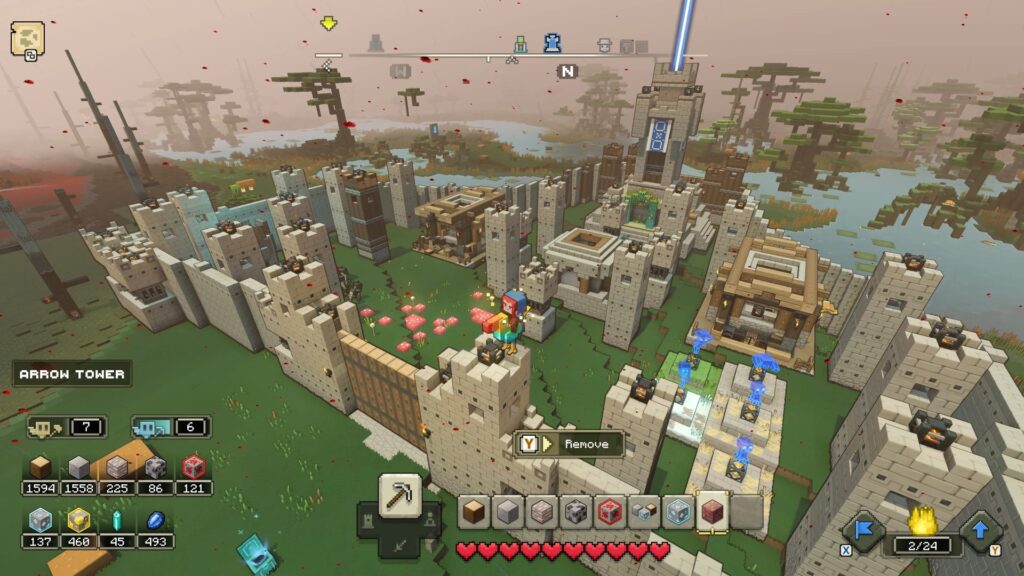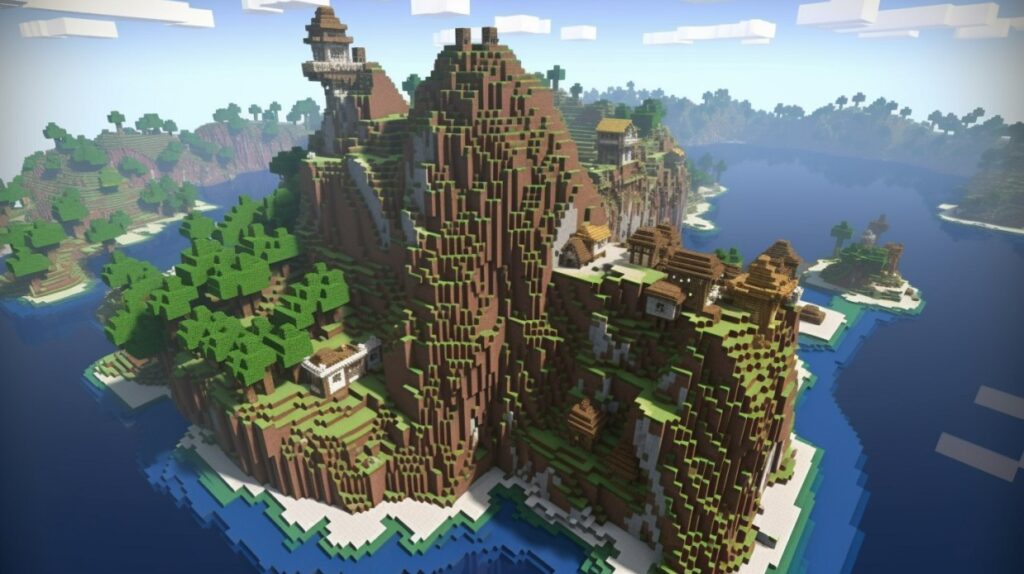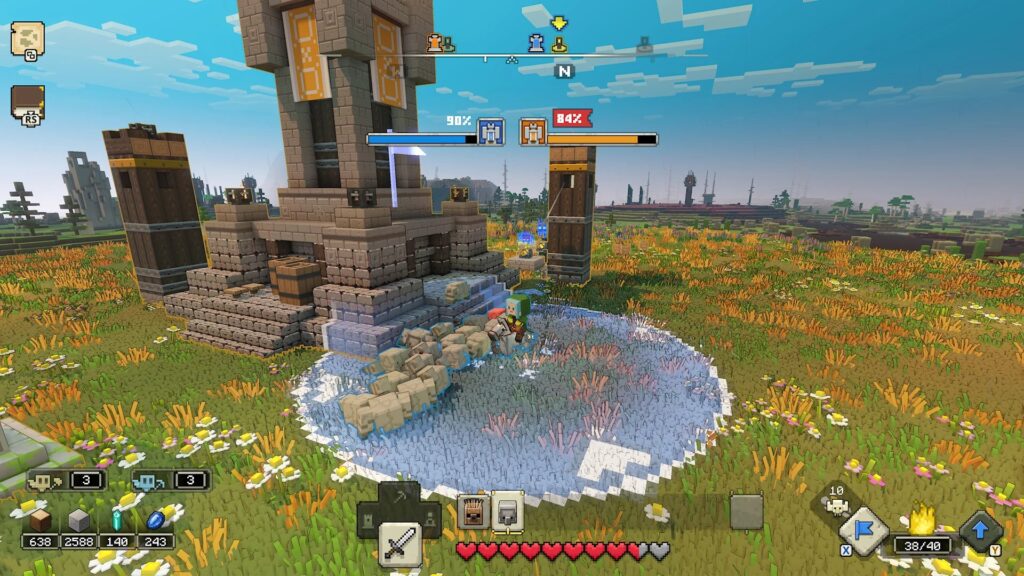Are you a fan of strategy games? If so, you might be interested in Minecraft Legends, the simplified action-RTS game by Mojang and Blackbird Interactive. In this game, you’ll have to make decisions about which units to create, where to allocate resources, and which strategies to implement. The right choices lead to victory, while the wrong ones force you to adapt or suffer defeat.
One of Minecraft Legends’ greatest strengths is its simplicity.
One of Minecraft Legends’ greatest strengths is its simplicity. The game’s story is minimalistic, with the evil Piglins from the Nether invading and your job being to build up forces to drive them back. You’ll explore a procedurally generated continent for resources, allies, and secrets to discover, destroy Piglin bases, and defend friendly settlements from the invaders. Once you’ve cleared out all the Piglins, victory is yours, and you can start a new run on a brand new map.
Minecraft’s iconic blocky style is well implemented in Legends. The entire world looks like it was pulled straight from the main Minecraft series, with landscapes, NPCs, and blocks of ore that are identical to their counterparts. The game looks great thanks to a vibrant color palette and some excellent lighting. Minecraft tradition also dictates that nights bring added danger from aggressive enemies, but it’s hard to dread their arrival when it’s preceded by gorgeous sunsets over stunning vistas.

Unlike other strategy games, such as Starcraft or Command and Conquer, where you occupy the seat of some far-off overseer commanding a complex legion of forces from above the landscape, Legends puts you on the field of battle directly. It’s similar to the Overlord series, giving you control of a warrior fighting alongside a small squad of summonable units. The game features a handful of interesting unit types, each with a very clear niche that they fill. Cobblestone Golems have a lot of health but aren’t great at dealing damage quickly, Plank Golems are the opposite, and Mossy Golems heal. The straightforward gameplay makes it easy to jump right into the action without a steep learning curve or thick manual to memorize.
Simplicity is a Benefit and a Drawback
Smaller army sizes in Minecraft Legends make it easy to manage your soldiers, regardless of whether you’re using a gamepad or mouse controls. The armies are made up of dozens of units, making it simple to give commands like “go kill things over there” or “follow me”. It’s a lot of fun to smash the gate of a Piglin Fort and watch as your horde runs over everything in its path.
However, this simplicity does have its drawbacks. While certain units are designed to counter specific enemies, it’s often easier to overwhelm enemies with sheer numbers, taking the thought out of battles. Abundant resources and the ability to instantly spawn forces only add to this problem.
Another downside is the lack of control over mixed troops. There’s no way to create battle groups of specific units, only command all of a certain unit type at once. It would have been great to issue orders to a squad of zombies mixed with healing units to push the front line, supported by a group of archers raining pain upon the Piglins. Unfortunately, this level of fine control isn’t feasible in the game.


However, the fact that you participate directly in battles offers opportunities to make clever choices. As the hero, you’re more powerful than any individual soldier in your army.
You’re always mounted and armed with a sword that swings in wide arcs, allowing you to create swarms of Cobblestone Golems for an invasion and tell them to focus on destroying buildings while you protect them, or send units to guard one side of a friendly settlement while you cover the other. This mental push-pull is what makes strategy games so enjoyable.
Resource Gathering and Building
One of the defining features of Minecraft Legends is its resource gathering and building mechanics, which are both slick and intuitive. Allays, small fairy-like creatures, assist players with these tasks. One type focuses on resource gathering, allowing players to point them towards groves of trees or quarries filled with ore, and they strip the resources independently. The other type carries out building instructions, quickly assembling structures like golem spawners or arrow towers, provided the resources are available.
Minecraft Legends features the traditional RTS gameplay mechanics of resource gathering and building. The game features a simplified set of Minecraft materials, starting with wood and stone and expanding to include iron, redstone, and more. The player constructs three types of buildings: defensive structures like walls and turrets, spawners for combat units, and improvements around the central hub, the Well of Fate. These improvements unlock new abilities, such as access to new materials, better carrying capacity, and ways to interact with various points of interest.


However, unlike Minecraft’s main game, the player does not perform any of these tasks themselves. Instead, they delegate all mining and crafting to the game’s allays, small sprites that can be assigned to build structures or gather resources within a given area. There is a limit to the number of building and gathering allays, restricting the player’s ability to perform multiple tasks at once.
The Piglin army attacks settlements most nights, and players must quickly assemble walls and gates to hold them back. The industrious Allays make this process a breeze, and players can experiment with building structures like the Architect Hut to repair buildings or the Masonry to convert wooden defensive structures to stone. These choices drain resources, but they can lead to a much more fortified town that’s better able to withstand the rampaging armies of the Nether. The choice of whether to forage for more resources to keep building or hunker down for the coming battle is compelling, and players will relish each opportunity to make and execute a plan.
The independent operation of Allays feeds into the strategy elements of combat in interesting ways.
The independent operation of Allays feeds into the strategy elements of combat in interesting ways. Players can defend a settlement from an invading force of Piglins and command walls be built as they fight. If wood supplies run low, players must ride to a nearby forest and start the collection process, letting both sets of Allays work while they continue the fight. Piglins will go out of their way to target the fragile Allays, keeping this mid-battle backup from being too overpowered by forcing players to think twice before leaving them unprotected.
The Well of Fates is the primary home base in Minecraft Legends. It is where players start, the default respawn location when they die, and where they do most of their upgrading. Destroyed Piglin structures drop Prismarine, which is used to construct upgrade structures that allow players to do things like command more troops or store more materials in general. Players must make tough decisions about whether to increase the size of their army, open up opportunities to mine specialty ores like coal and redstone, or add more Allays to expedite resource gathering, as there is a limited number of places these structures can be built.
Combat and Difficulty
In battle, you take control of your hero unit, who is mounted and armed with a sword that can be swung in wide arcs. Your hero is significantly more powerful than any individual soldier in your army, so you’ll want to use them to protect your weaker units and to take out enemy hero units when they appear. You’ll also need to keep an eye on your hero’s health, as they can’t be healed by any of your units and if they fall in battle, it’s game over.
The Piglins in Minecraft Legends don’t sit idly by waiting for players to build up armies to come and attack them. They produce their own bases and outposts, which become increasingly complex as time goes on. What begins as quick pillaging of a few buildings at the start eventually becomes long sieges of intricate fortresses that can take multiple in-game days. The constant mental struggle of deciding whether to press the advantage or turn attention toward defending vulnerable areas elsewhere creates a nice sense of tension.
However, the difficulty curve has a few kinks in it. The last few hours of a 16-hour playthrough can slow to a crawl as enemies with massive amounts of health, like the heavily armored Pigmadillos, join the fray. While it’s great that enemies with unique designs and attacks continue to show up, the size of the armies they fill becomes a slog. This is an even bigger problem when attacking an enemy base on a high plateau – assembling an attack force only to realize half of them fell off a cliff on the march up due to suspect pathfinding is frustrating. These endgame struggles detract from Minecraft Legends’ potential as an onboarding opportunity for the strategy genre.
The camera can also be unwieldy, especially when trying to target a specific unit.
The combat in Minecraft Legends is quite simplistic and requires constant micromanagement, which can be frustrating due to imprecise controls. You need to spawn a group of troops, lead them to the front lines, and aim them at buildings or enemies. Once the target is destroyed, you regroup and move on to the next one. Occasionally, you’ll have to go back to the spawners to create more units before heading back to the front lines.
The battles themselves can be a bit chaotic, with units clustering together and becoming difficult to distinguish from one another. The camera can also be unwieldy, especially when trying to target a specific unit. The game tries to help by highlighting the unit you’re currently targeting, but this doesn’t always work as intended.
Despite these issues, the battles can be enjoyable, especially when you execute a well-planned strategy. It’s satisfying to send your minions to attack an enemy stronghold while your hero unit holds off their forces, and the game provides plenty of opportunities for creative tactics. For example, you can use creepers to blow holes in enemy walls, or use zombie units to draw fire away from your more vulnerable troops.


Fortunately, good construction options can mitigate some of the game’s pain points. Siege tools like the Redstone Launcher, which acts somewhat like a long-range cannon fixture, can help clear a landing point, and crafting bridges or stairs to cross gaps and ascend hills is a snap.
The Cure Netherrack ability that slowly transforms the corrupted ground under Piglin bases is a standout difference maker, too, allowing the assembly of buildings and golem spawners inside enemy territory. These are fun ways to turn the tide, but it can be a little daunting that making the most of every single tool in the player’s belt feels like the only viable option to clear the highest level outposts.
Multiplayer
Minecraft Legends offers a fun multiplayer experience that shines when playing with friends. You can play the entire campaign in co-op with up to three other players, splitting resources while still retaining full autonomy to act independently. This allows players to divide tasks such as resource gathering, base building, and combat, making the game much more enjoyable. Charging into battle with your friends and sharing the excitement of victory is an experience that never gets old.
PVP in Minecraft Legends has a unique twist to it. Two teams go head-to-head on a randomized map, with players on each team controlling a hero while sharing resources and golems. Matchmade games are designed for 3v3 or 4v4, while private games can have any mix of up to four players on either side. The strategic elements that human opponents bring are far more interesting than facing off against the CPU. In one game, my team destroyed Piglin bases early on to afford upgrades quickly and focus on building the most powerful army possible before engaging in combat with other players. In another game, we were defeated when our opponents secretly built a Redstone Launcher within range of our base, forcing us to defend our structures while they were destroyed.
One downside of Minecraft Legends is that its single-player campaign mode requires an always-online connection.
One downside of Minecraft Legends is that its single-player campaign mode requires an always-online connection. This means that even when you pause the game to attend to real-life matters, the game continues to play in the background, causing you to lose troops and allowing the enemy to advance unchecked. The same is true when you’re trying to rearrange your UI to build attacking structures and your units are wiped out while you’re navigating menus. This can be frustrating and is definitely not an ideal design choice.
Final Thoughts
Minecraft Legends is a simplified yet engaging real-time strategy game set in the familiar world of Minecraft. The cooperative and PVP multiplayer modes are particularly enjoyable. However, the lack of control over individual units during combat and the frustrating always-online requirement for single-player mode bring down the overall experience. Despite its flaws, Minecraft Legends is still worth a try for fans of the strategy genre and the Minecraft universe.
Summary
Minecraft Legends offers a streamlined RTS experience that simplifies the genre’s complexities. While it does a good job of incorporating Minecraft’s aesthetic and worker units, the combat feels overly simplified and the game’s difficulty curve can be frustrating. Furthermore, the always-online requirement for single-player mode and lack of creativity and experimentation options make it hard to determine the target audience for this game.












